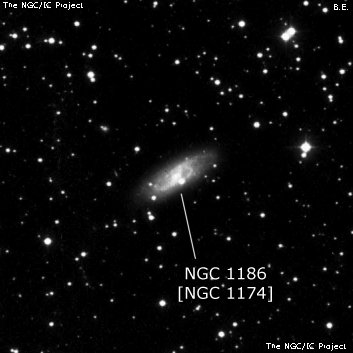
William Herschel discovered NGC 1186 = H IV-43 = h281 on 17 Oct 1786 (sweep 614) and reported "a pretty S star with a very F nebulosity to the nf side, of very little extent." On 24 Oct 1786 (sweep 621), he noted "a pretty B star with two faint branches." John Herschel also described it on 23 Dec 1831 (sweep 389) as "a star 14m with some kind of faint nebulous appendage." The NGC position is accurate although Herschel's class IV refers to objects that appeared to be planetary nebulae.
R.J. Mitchell and Samuel Hunter, observing assistants on the 72", both failed to find this galaxy and d'Arrest tried to follow up in 1863 but was also unsuccessful. Bigourdan observed it though, and suggested it was a "variable nebula", because of the mixed results. Rudolph Spitaler also observed it on 12 Mar 1891 with the 27-inch Vienna refractor and described it as "elongated NW-SE, but its boundaries are not so regularly shaped it could be described as elliptical. On its south preceding side is a mag 11 star. In the southeast side the nebula is limited by two faint stars, but at times the edge of the nebula seems to stretch beyond these. The brightest part is northeast of the former star. I estimate the length to be 2'."
Lewis Swift independently found this galaxy and superimposed star on 31 Aug 1883 but placed Sw. IV-11 one minute of RA too far west. Dreyer took this as a different object and it was catalogued as NGC 1174. So, NGC 1174 = NGC 1186. Finally, it was checked for variability on photographs taken with the Mt Wilson 60-inch in 1914 and 1917, with no change found.
400/500mm - 17.5" (10/24/87): fairly faint, moderately large, very elongated 3:1 WNW-ESE. A mag 13 star, superimposed just southwest of the center, detracts from viewing.
Notes by Steve Gottlieb